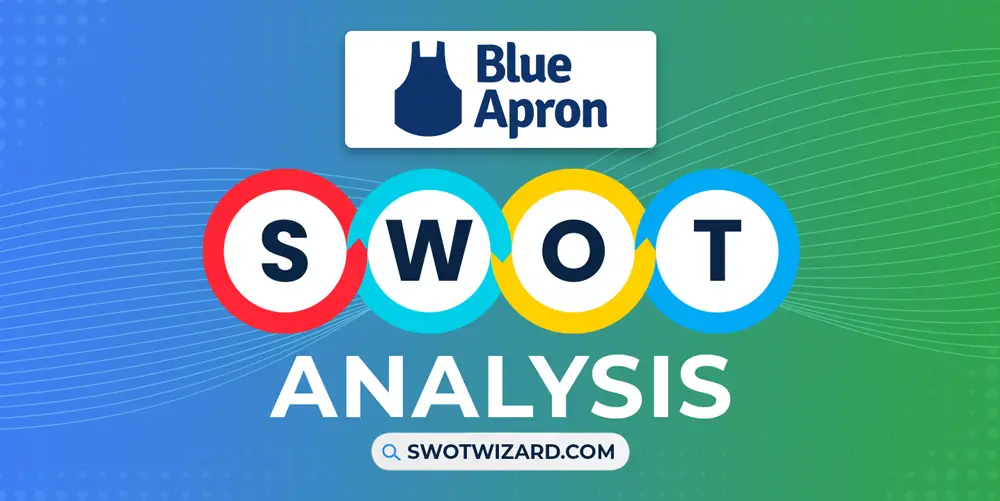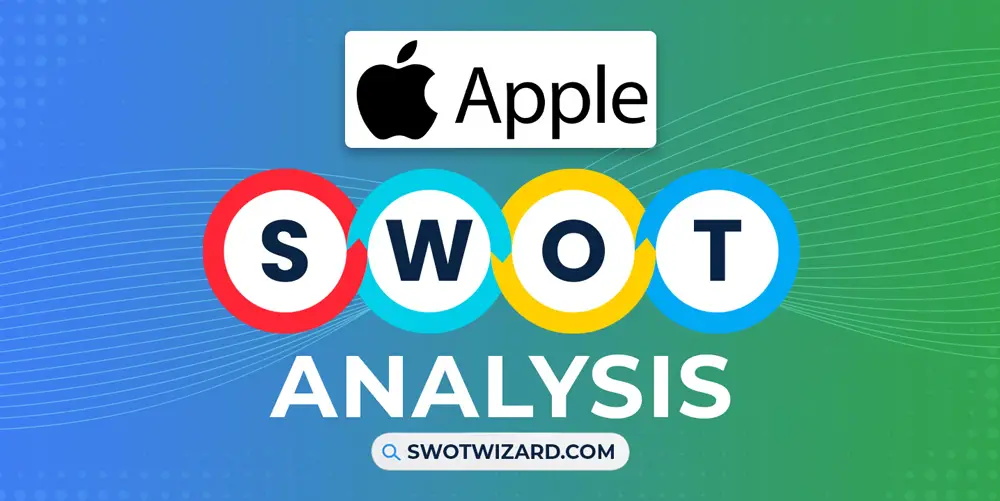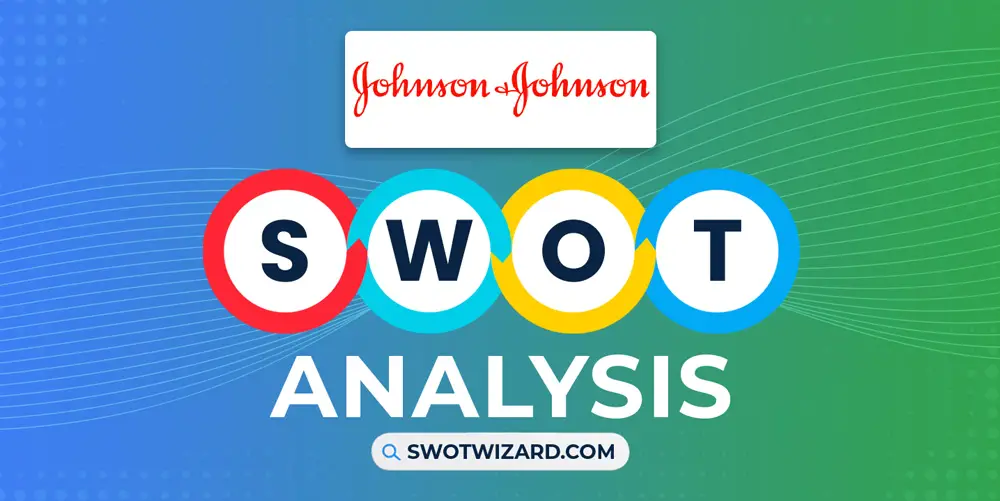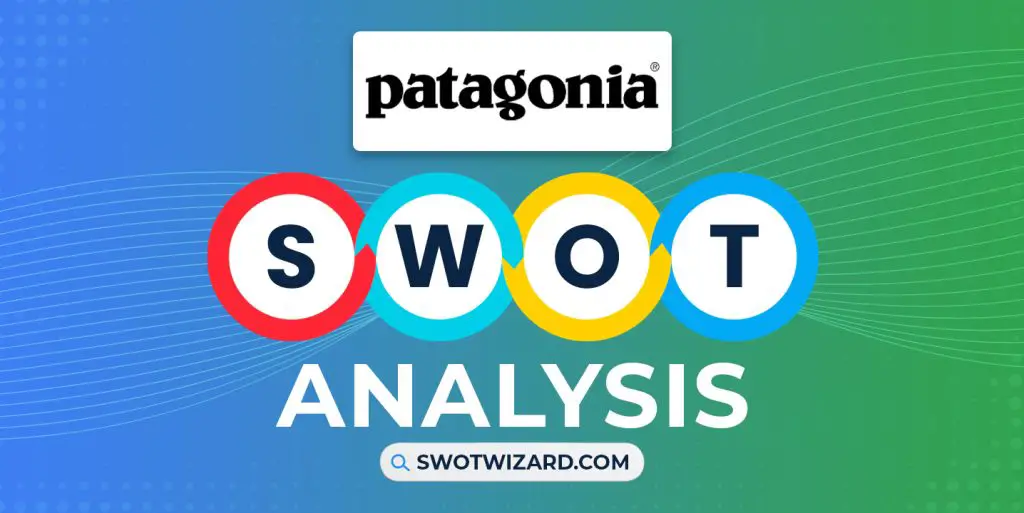Blue Apron is a rare example of the Blue Ocean and nativity advantages both failing a company. Currently, it’s the world’s 6924th company in terms of market cap, falling behind its competitors. To understand how being the 1st in a market can be disastrous, let’s take a quick look at this startup with Blue Apron SWOT analysis.
Blue Apron: Company Overview
| Company | Blue Apron Inc. |
| Industry | Meal Kit |
| Founded | August, 2012 |
| Founder | Matt Wadiak, Matt Salzberg, Ilia Papas |
| CEO | Linda Findley |
| Headquarter | New York, U.S. |
| No. of Employees | 1,988+ |
| Annual Revenue | $470.4 million (FY 2021) |
| Website | blueapron.com |
Blue Apron was founded in August 2012 by Matt Salzberg, Ilia Papas, and Matt Wadiak. The trio shipped the 1st 30 orders from a commercial kitchen in Long Island City, including ingredients with a recipe in each box. While it had become a $2 billion company within only 36 months of launching, it was reported for health and safety violations in October 2016.
Now, the company is a US-based meal kit subscription service. It is headquartered in New York City with only 1,988 employees. In 2022, its TTM revenue had decreased to a mere $0.45 billion, losing market share and giving ground to competitors.
Product & Services of Blue Apron
Kitchen Tools | Pantry Staples | Packaged Meal Kits | Wine Bundles
Blue Apron Competitors
Home Chef | Hello Fresh | Plated | Sun Basket | Snap Kitchen | Freshly | PeachDish | Gobble
Did You Know?
Blue Apron’s name comes from the tradition of beginner cooks donning blue aprons, indicating its target audience is home cooks.
Strengths – Blue Apron SWOT Analysis
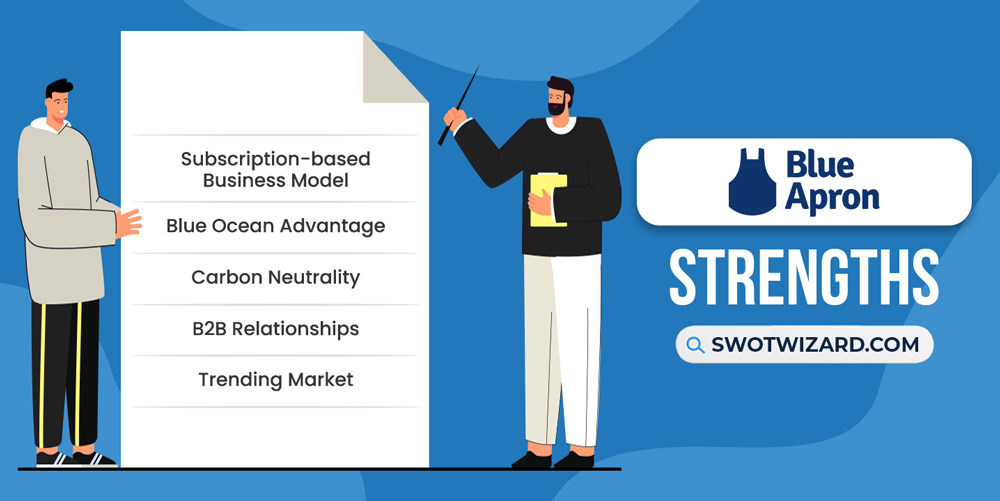
Subscription-based Business Model: Blue Apron’s business is based on the subscription-based model, which has recently become a popular and powerful revenue generator. Aside from a continuous, stable revenue stream, this model creates high customer engagement, and controlled growth, expands the customer base, and increases business valuation. Blue Apron’s use of the subscription business model generates a large pile of customer data, which helps it with effective marketing, WOM marketing, generating customer leads, and forecasting market trends.
Blue Ocean Advantage: Blue Apron was founded in August 2012, with no domestic competition in the US. While HelloFresh launched in October 2011, it was launched in Berlin and took years before properly invading the US market. Blue Apron had no one competing for its customer base, set the market conditions in the US, and had full control over its markup. This is why Blue Apron only took 36 months after its launch to become a $2 billion company with 2,500 employees.
Carbon Neutrality: By 31 March 2022, Blue Apron achieved full carbon neutrality in its operations. The company targeted carbon neutrality from 2021 Q1 and calculated that it had to offset 124,000 metric tons worth of CO2 production, considering all 3 scopes defined by the GHG protocol. By offsetting its CO2 emissions, the company creates new jobs and greener methods of farming and invests in CO2 emission-related projects. By offsetting its emissions, Blue Apron creates a positive public image, employs a powerful marketing tactic, and increases brand loyalty.
B2B Relationships: According to Blue Apron, 80% of its food items are resourced directly from producers. By forming contracts directly with the producers, Blue Apron can deliver fresh ingredients right to its customer’s doorstep. Also, the company can keep its prices low through these direct contracts, ensure that it is getting the desired quality in its food items consistently, and even avoid significant price hikes due to inflation. Through its B2B relationships, Blue Apron can provide an attractive end product at rates ideal for a subscription service.
Trending Market: Projecting growth at a CAGR of 14.9% between 2022-2031, the meal kit market is taking over the food industry rapidly. In 2021, the meal kit market was valued at $11.1 billion and was projected to reach $43.4 billion by 2031. Since the pandemic, meal kit services have seen higher traffic, and newer brands were getting 2000 orders per week in 2020. Blue Apron’s revenue is assured in such a prosperous and trending market, even if it only manages to hold on to its market share.
Weaknesses – Blue Apron SWOT Analysis
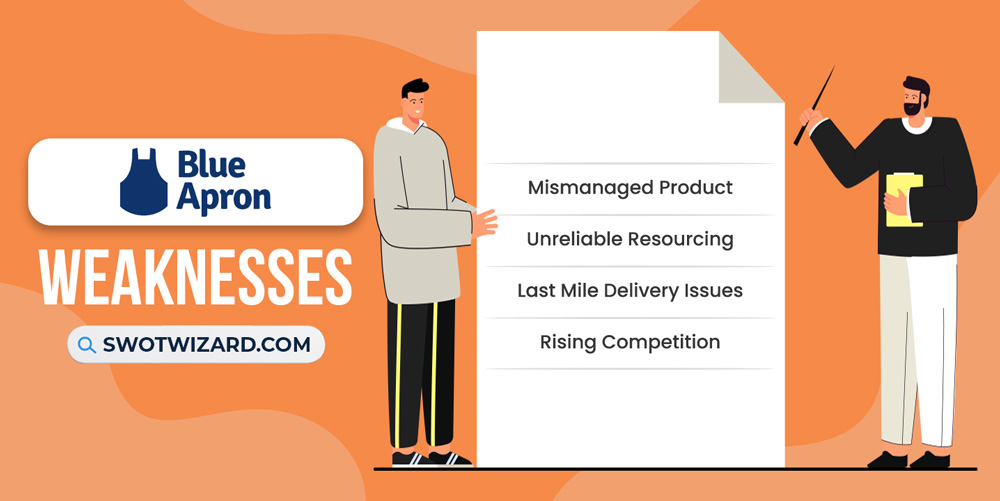
Mismanaged Product: Blue Apron’s products are all biodegradable groceries and require careful packaging and portioning. Customers have complained of receiving rotten ingredients, mismanaged portions, and unwashed or poorly packaged ingredients. Some customers have tried to save portions of the ingredients only to find them rotting soon after. While formal reviews are less forthcoming with these issues, customers are commenting relentlessly that they have been plagued with these issues.
Unreliable Resourcing: Blue Apron deals with fresh produce and requires a consistent supply of quality ingredients to provide meal kits to its customers. However, its contracted suppliers cannot always guarantee quantity or quality. From 2021, vegetables and fruits have been more expensive and arduous to produce and expensive to ship. With delays in harvest and delays in supply, Blue Apron is bound to receive perished or unusable ingredients that it cannot serve its customers.
Last Mile Delivery Issues: Blue Apron uses FedEx and other logistics companies for its last-mile delivery, relinquishing control of its meal kit delivery to 3rd parties. Even if the meal kit is in perfect condition before shipping, it can get damaged and rot from reckless handling and delayed shipping. Customers have complained directly about using these delivery businesses to Blue Apron before, stating that meals have arrived days late or have gone missing.
Rising Competition: The US meal kit market generated over $7.64 billion in 2022, but Blue Apron couldn’t truly benefit from it. In 2022, HelloFresh had taken over 70% of the meal kit market and generated $3.37 billion as its revenue. Meanwhile, Blue Apron had shrunk to 13% market share by 2020 and only managed to generate half a billion USD in 2021. Even Home Chef was ahead of the US meal kit giant in 2020, holding over 18% market share.
Opportunities – Blue Apron SWOT Analysis

Specializing Meal Kits: Blue Apron can offer specialized gourmet meal kits that are inspired or designed by famous chefs across the world. These kits can also be a tasting menu or have a theme such as rare cheeses. These meal kits will draw a higher economic class to Blue Apron, who the company can charge more.
Selling Groceries: Blue Apron can also use its surplus groceries to launch or supply a home delivery groceries service. The app and website can use user data to suggest an entire monthly plan for a customer based on their diet and budget. By providing a daily supply, this can become another subscription service with a lower customer base but profit from surplus.
Building New Verticals: Blue Apron can contract suppliers and fund them to grow their business in exchange for acquiring the businesses. This decision would allow the company to build its verticals that supply all the food items it needs. By becoming self-sufficient, Blue Apron can keep costs low and profits high while customers choose its service for convenience and quality in a falling economy.
Threats – Blue Apron SWOT Analysis
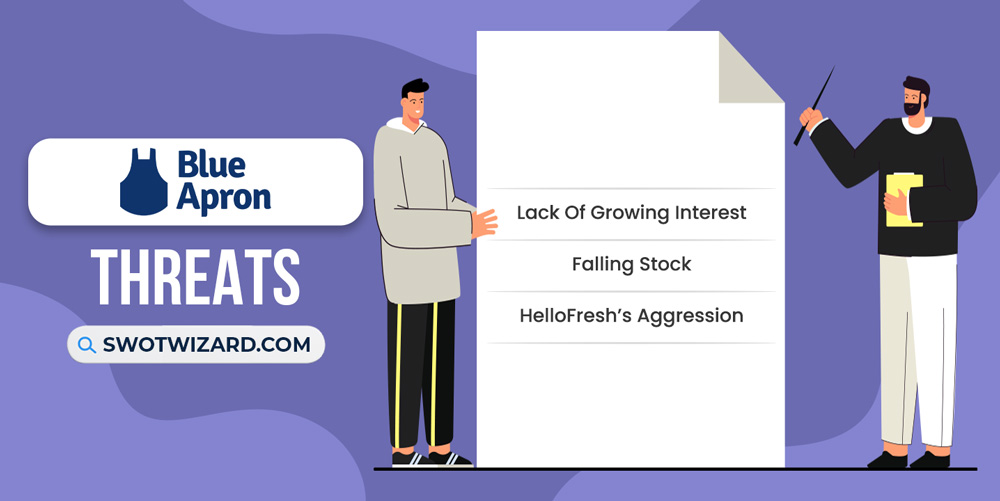
Lack Of Growing Interest: Even in the thick of the pandemic in 2020, very few customers showed any real interest in purchasing a meal kit service subscription. Surveyed in May 2020, 13% of US customers with a $100,000 income, 7% of customers with a $100,000-$50,000 income, and 8% of customers with sub $50,000 income had shown interest in spending more on meal kit delivery. An average of 60% of customers planned on spending the same amount, which sustained the meal kit industry but left no room for immediate, rapid growth. With Blue Apron’s shrinking popularity, the lack of growing interest in meal kits now could spell its doom.
Falling Stock: Blue Apron’s share price fell by 50% in November 2022 and fell again in February 2023 by an additional 25.19%. This was caused by Blue Apron filing for an ATM equity program worth $70 million. While this may fund Blue Apron in the short term, it can ward off future investors.
HelloFresh’s Aggression: Since invading the US market, HelloFresh has targeted Blue Apron aggressively, eating away at its market share, offering low prices, and becoming its chief alternative through targeted ads. HelloFresh recipes appeal to the average home cook and offer value for money. With such aggressive competition, HelloFresh can kick Blue Apron from the meal kit market.
[Bonus Infographic] SWOT Analysis of Blue Apron
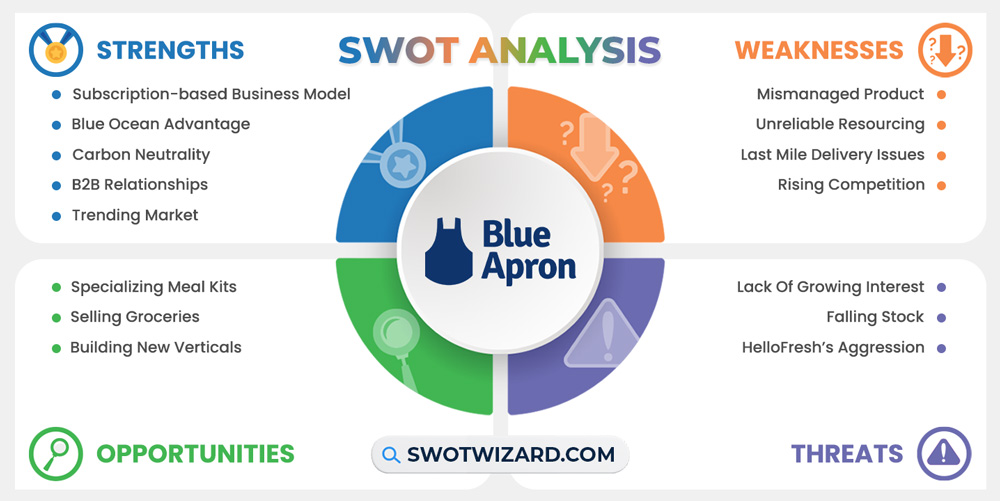
Recommendations for Blue Apron
If it wants to restore its market dominance, Blue Apron can consider these options.
- Blue Apron should double down on gourmet meal kits made by famous chefs for its wealthy customers.
- It should disprove or stop paid reviews and engage more with customers.
- It can offer special meal kits made in collaboration with YouTube chefs.
- It should market its CO2 offset projects aggressively.
- The company can take control of its last-mile delivery to preserve meal kit quality.
Frequently Asked Questions (FAQs)
How to save money when ordering from Blue Apron?
The more people you order for, the cheaper Blue Apron’s meal kits get.
Can Blue Apron meals come pre-cooked?
Blue Apron’s Heat & Eat meals are pre-cooked and only need about 5 minutes of heating to eat.
Final Words on Blue Apron SWOT Analysis
Blue Apron is an example of the Blue Ocean advantage’s failings. Being the first US meal kit company painted a target on its back, and it couldn’t sustain itself against aggressive competitors. However, there is still time for a complete restructuring of the supply chain, product design, and marketing, which may save the company.
References
- Wikipedia contributors. (n.d.). Blue Apron Inc. Wikipedia.
- Blue Apron Holdings (APRN) – Market capitalization. (n.d.). CompaniesMarketCap.
- Scalco, D. (2022, April 29). The History Of Blue Apron: How They Became One Of The Most Popular Meal Kits. Food Box HQ.
- SHONTELL, A. (2015, October 20). How Blue Apron Became a $2 Billion Startup in 3 Years. Inc.
- Blue Apron investigation uncovers severe code violations, violence at packing plant. (2016, November 27). Fox News.
- Parker, G. (2018, December 1). 20 Things You Didn’t Know about Blue Apron. Money Inc.
- Mukhopadhyay, P. (2020, October 26). How A Subscription Business Can Increase Business Valuation. Forbes.
- Benefits & Advantages of Subscription-Based Business Models. (n.d.). Bank of America.
- Blue Ocean Strategy: Meaning, Advantages, and Disadvantages. (n.d.). EconPosts.
- Shontell, A. (2015, October 20). How 3 guys created Blue Apron, a $2 billion recipe-delivery business with 2,500 employees, in 36 months. Business Insider.
- Blue Apron is Carbon Neutral – Extra Helpings. (2022, April 5). Blue Apron Blog.
- Market Drivers Shaping Future Growth, Revenue $43.4 Billion By 2031 | Blue Apron, Daily Harvest, Fresh N’ Lean. (2023, February 18). MENAFN.
- Ramirez, E. (2020, December 14). Meal Kits Expand In Wake Of Pandemic—EKOOK Launches In U.S. Forbes.
- An Unpaid Review of Blue Apron. (n.d.). Everyday Reading.
- Zimmerman, S. (2021, November 18). Fresh fruit and vegetable supply threatened by rising disruptions. Supply Chain Dive.
- Blue Apron Reviews. (n.d.). Trustpilot.
- Van Gelder, K. (2022b, November 29). Meal kits in the U.S. – statistics & facts. Statista.
- Van Gelder, K. (2022a, February 3). Estimated market shares of meal kit companies in the U.S. 2020. Statista.
- Blue Apron falls 25% as volatile trading continues. (n.d.). MSN.
- Business Wire. (2023, February 10). Blue Apron Files At-the-Market Equity Offering Program. Benzinga.
- HELM, B. (n.d.). The World’s Most Ruthless Food Startup: The Inside Story of How HelloFresh Clawed Its Way to the Top. Inc.
- Brown, S., & Watsky, D. (2021, January 29). Blue Apron vs. HelloFresh: Comparing meal kit price, taste, ease of use and more. CNET.

